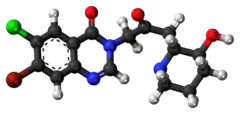Halofuginone
 | |
 | |
| Clinical data | |
|---|---|
| Trade names | Halocur |
| AHFS/Drugs.com | International Drug Names |
| ATCvet code | |
| Legal status | |
| Legal status |
|
| Identifiers | |
IUPAC name
| |
| CAS Number | |
| PubChem CID | |
| ChemSpider | |
| UNII | |
| ChEMBL | |
| CompTox Dashboard (EPA) | |
| Chemical and physical data | |
| Formula | C16H17BrClN3O3 |
| Molar mass | 414.68 g·mol−1 |
| 3D model (JSmol) | |
SMILES
| |
InChI
| |
| | |
Halofuginone, sold under the brand name Halocur, is a coccidiostat used in veterinary medicine. It is a synthetic halogenated derivative of febrifugine, a natural quinazolinone alkaloid which can be found in the Chinese herb Dichroa febrifuga (Chang Shan).[1] Collgard Biopharmaceuticals is developing halofuginone for the treatment of scleroderma and it has received orphan drug designation from the U.S. Food and Drug Administration.[2]
Halofuginone inhibits the development of T helper 17 cells, immune cells that play an important role in autoimmune disease, but it does not affect other kinds of T cells which are involved in normal immune function.[3] Halofuginone therefore has potential for the treatment of autoimmune disorders.[4]
Halofuginone is also an inhibitor of collagen type I gene expression and as a consequence it may inhibit tumor cell growth.[1] Halofuginone exerts its effects by acting as a high affinity inhibitor of the enzyme glutamyl-prolyl tRNA synthetase. Inhibition of prolyl tRNA charging leads to the accumulation of uncharged prolyl tRNAs, which serve as a signal to initiate the amino acid starvation response, which in turn exerts anti-inflammatory and anti-fibrotic effects.[5]
References
- 1 2 "Halofuginone hydrobromide". NCI Drug Dictionary. National Cancer Institute, National Institutes of Health, U.S. Department of Health and Human Services.
- ↑ "Halofuginone Receives FDA Orphan Drug Status For Scleroderma". WebCite. 10 March 2000. Archived from the original on 12 September 2012.
- ↑ Sundrud MS, Koralov SB, Feuerer M, Calado DP, Kozhaya AE, Rhule-Smith A, et al. (June 2009). "Halofuginone inhibits TH17 cell differentiation by activating the amino acid starvation response". Science. 324 (5932): 1334–8. Bibcode:2009Sci...324.1334S. doi:10.1126/science.1172638. PMC 2803727. PMID 19498172.
- ↑ Sundrud MS, Koralov SB, Feuerer M, Calado DP, Kozhaya AE, Rhule-Smith A, Lefebvre RE, Unutmaz D, Mazitschek R, Waldner H, Whitman M, Keller T, Rao A (June 2009). "Halofuginone inhibits TH17 cell differentiation by activating the amino acid starvation response". Science. 324 (5932): 1334–8. Bibcode:2009Sci...324.1334S. doi:10.1126/science.1172638. PMC 2803727. PMID 19498172. Lay summary – EurekAlert!.
{{cite journal}}: Cite uses deprecated parameter|lay-url=(help) - ↑ Keller TL, Zocco D, Sundrud MS, Hendrick M, Edenius M, Yum J, et al. (February 2012). "Halofuginone and other febrifugine derivatives inhibit prolyl-tRNA synthetase". Nature Chemical Biology. 8 (3): 311–7. doi:10.1038/nchembio.790. PMC 3281520. PMID 22327401.